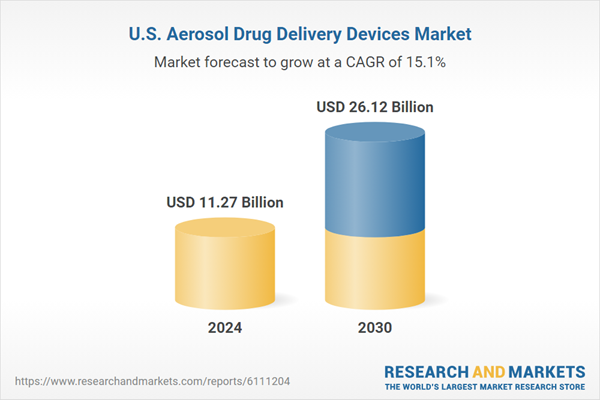Market Size & Trends
The U.S. aerosol drug delivery devices market size was estimated at USD 11.27 billion in 2024 and is expected to grow at a CAGR of 15.1% from 2025 to 2030. This is attributed to the rising prevalence of respiratory diseases, advancements in inhaler technology, increasing healthcare awareness, and the growing demand for home-based treatments. According to estimates from the American Lung Association, in 2022, approximately 11.7 million people, or 4.6% of adults, were diagnosed with COPD, including chronic bronchitis and emphysema.In addition, the WHO projects that by 2030, life-threatening respiratory diseases such as COPD, lung cancer, and tuberculosis will be responsible for nearly one in five deaths worldwide. Such factors contribute to the widespread adoption of aerosol devices, including inhalers and nebulizers. The growing emphasis on home healthcare contributes to the increased adoption of aerosol drug delivery devices.
Patients and healthcare providers are seeking treatments administered in the comfort of home, reducing the need for hospital visits and associated healthcare costs. This shift drives demand for portable, user-friendly aerosol delivery devices that facilitate self-management of respiratory conditions. The availability of e-commerce platforms and online pharmacies has further enhanced accessibility to these devices.
Technological advancements in aerosol drug delivery devices significantly propel market growth. Smart inhalers with sensors to monitor medication usage and improve adherence are becoming increasingly prevalent. Innovations include dual-chamber DPIs, breath-actuated MDIs, and environmentally friendly propellants. These technologies enhance drug delivery efficiency and patient convenience. For instance, Aerogen’s vibrating mesh nebulizer technology, now widely adopted in U.S. hospitals, exemplifies innovation in improving treatment for ventilated and non-ventilated patients. Such advancements make devices more straightforward and practical, encouraging patient and healthcare provider adoption.
The COVID-19 pandemic had a positive impact on the U.S. market. The demand for inhalers and nebulizers surged as COVID-19 and related respiratory conditions increased, particularly affecting patients with asthma and COPD who required ongoing respiratory care. The shift toward at-home healthcare and telemedicine drove the adoption of portable and smart inhalation devices. However, the pandemic disrupted supply chains, leading to raw material shortages and production delays, temporarily constraining market growth. In addition, hospitals prioritized critical COVID-19 care, causing a decline in non-urgent respiratory treatments and procedures. Despite these setbacks, the crisis accelerated digital health innovation and supported the long-term outlook of the U.S. market.
U.S. Aerosol Drug Delivery Devices Market Report Segmentation
This report forecasts revenue growth at the country level and provides an analysis of the latest industry trends in each of the sub-segments from 2018 to 2030. For this study, the analyst has segmented the U.S. aerosol drug delivery devices market report based on type, application, and distribution channel:Type Outlook (Revenue, USD Million, 2018 - 2030)
- Inhaler
- Pressurized Metered-Dose Inhaler (pMDI)
- Dry-Powder Inhaler (DPI)
- Nebulizer
- Jet
- Mesh
- Active
- Passive
- Ultrasonic
Application Outlook (Revenue, USD Million, 2018 - 2030)
- COPD
- Asthma
- Cystic Fibrosis
- Other (Pulmonary Arterial Hypertension (PAH), etc.)
Distribution Channel Outlook (Revenue, USD Million, 2018 - 2030)
- Retail Pharmacies
- Online Pharmacies
- Institutional Pharmacies
Why should you buy this report?
- Comprehensive Market Analysis: Gain detailed insights into the global market across major regions and segments.
- Competitive Landscape: Explore the market presence of key players worldwide.
- Future Trends: Discover the pivotal trends and drivers shaping the future of the global market.
- Actionable Recommendations: Utilize insights to uncover new revenue streams and guide strategic business decisions.
This report addresses:
- Market intelligence to enable effective decision-making
- Market estimates and forecasts from 2018 to 2030
- Growth opportunities and trend analyses
- Segment and regional revenue forecasts for market assessment
- Competition strategy and market share analysis
- Product innovation listing for you to stay ahead of the curve
- COVID-19's impact and how to sustain in these fast-evolving markets
This product will be delivered within 1-3 business days.
Table of Contents
Companies Mentioned
- AptarGroup, Inc.
- Koninklijke Philips N.V.
- AstraZeneca
- Novartis AG
- Sanofi
- OMRON Corporation
- Medline Industries, LP.
- GF Health Products, Inc.
- DRIVE MEDICAL GMBH & CO. KG
- Teva Pharmaceutical Industries Ltd
- Aerogen (Stamford Devices Limited Group)
- Sensirion AG
- PARI Respiratory Equipment, Inc.
- Catalent, Inc
- Pfizer Inc.
- Beurer GmbH
Table Information
| Report Attribute | Details |
|---|---|
| No. of Pages | 100 |
| Published | June 2025 |
| Forecast Period | 2024 - 2030 |
| Estimated Market Value ( USD | $ 11.27 Billion |
| Forecasted Market Value ( USD | $ 26.12 Billion |
| Compound Annual Growth Rate | 15.1% |
| Regions Covered | United States |
| No. of Companies Mentioned | 16 |









